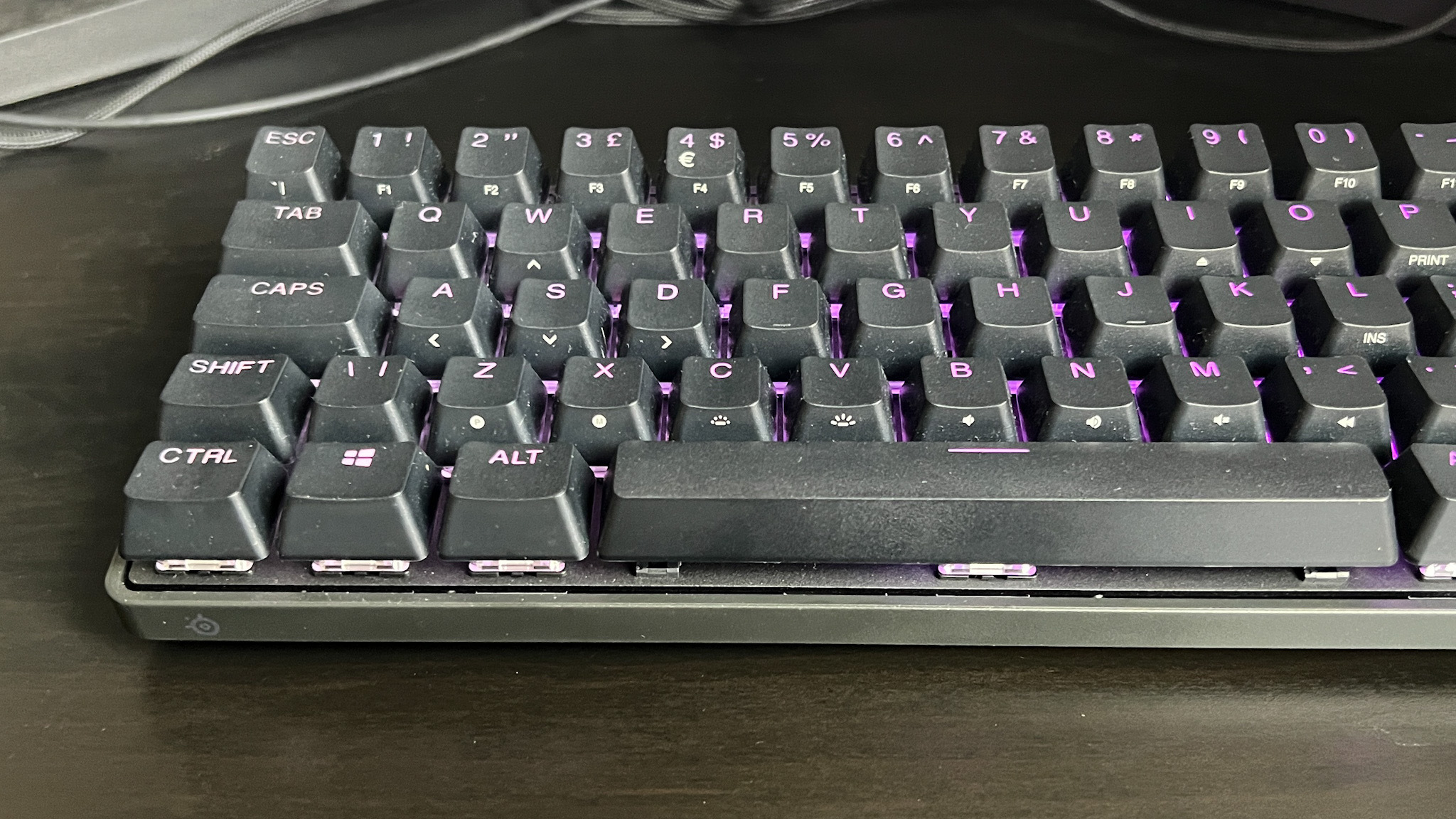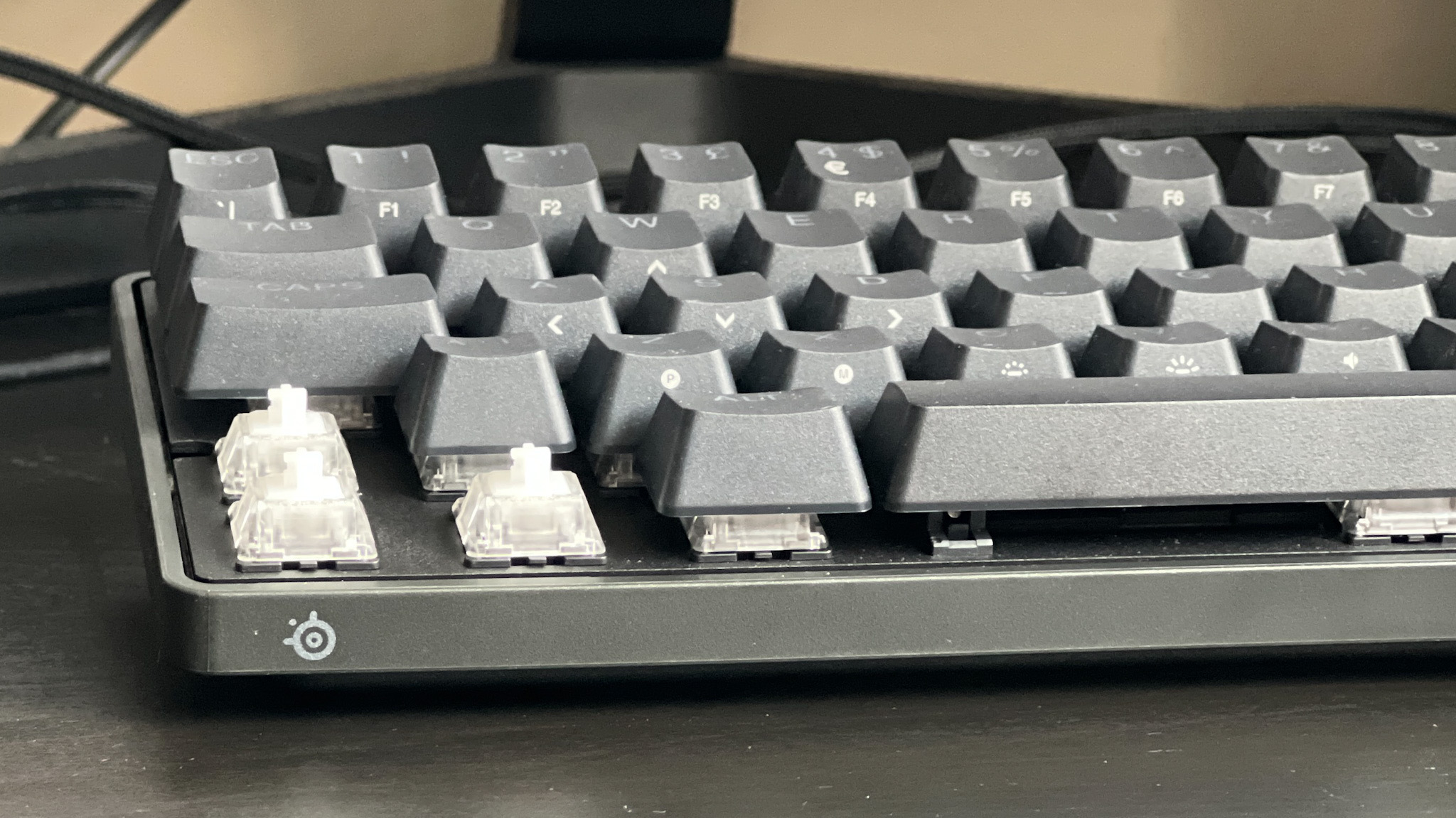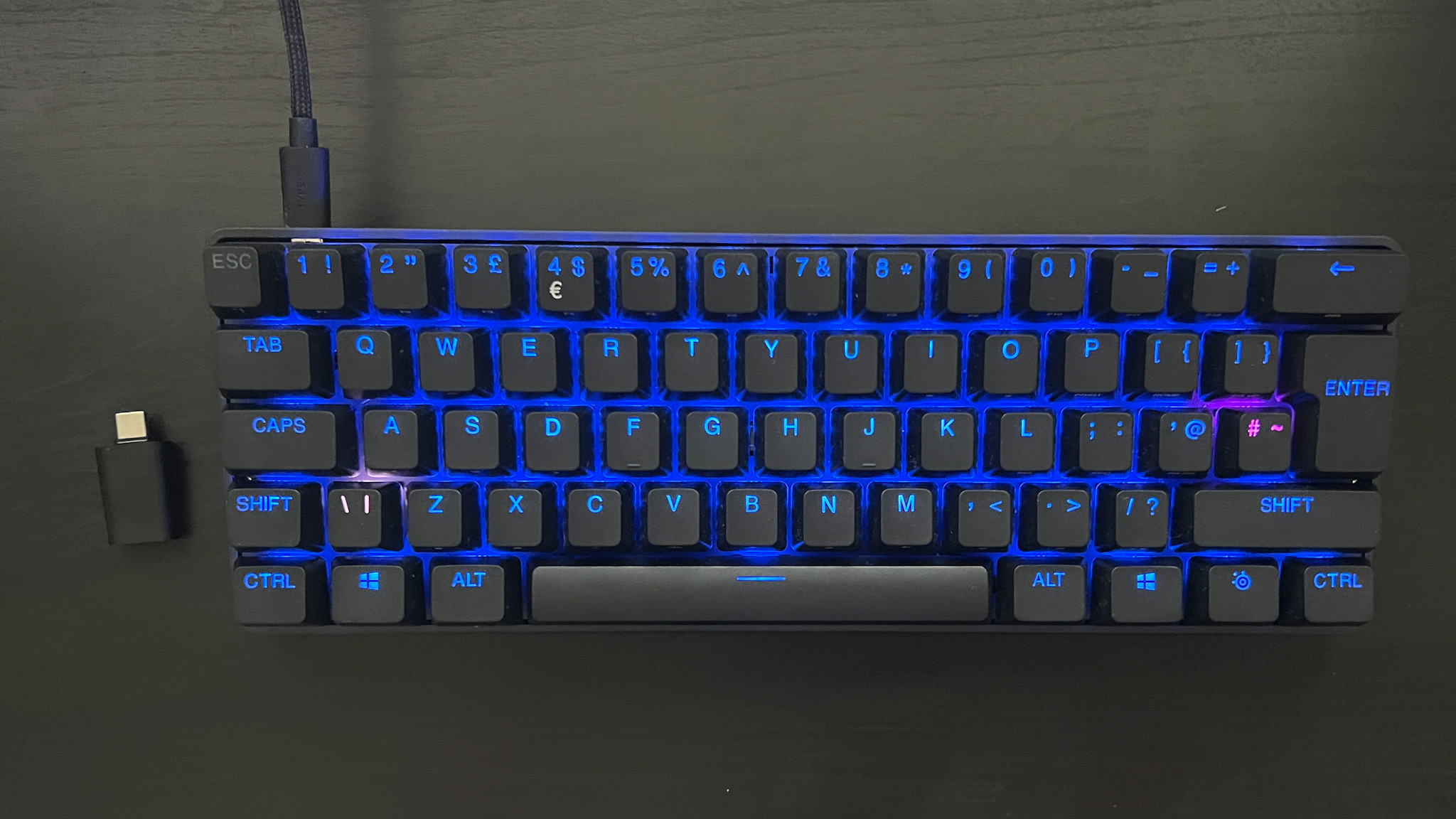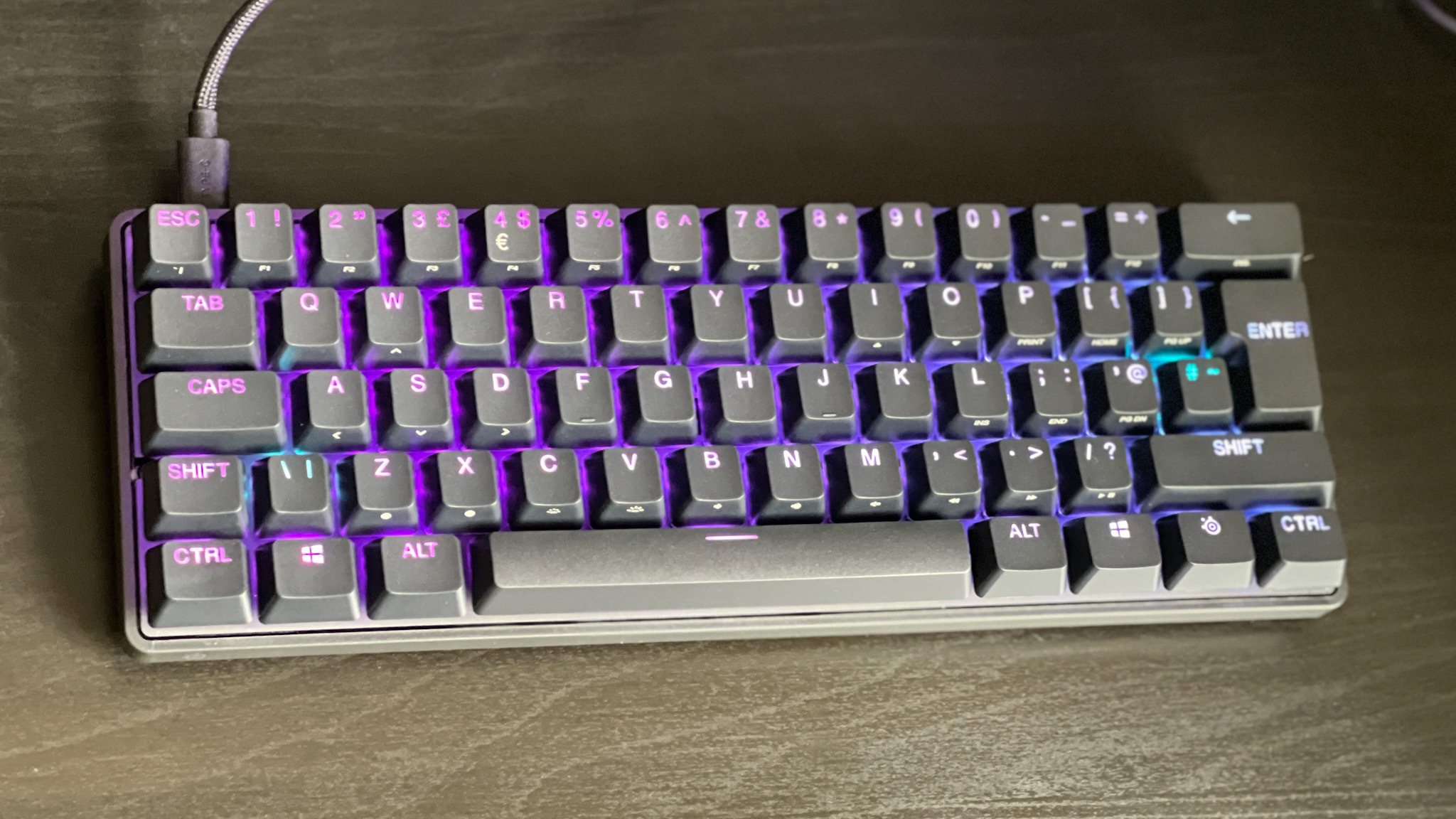GamesRadar+ Verdict
The SteelSeries Apex Pro Mini offers a whole new world of adjustable switches, and a level of flexibility we haven't seen from the brand yet. With a high asking price and a smaller 60% form factor, though, this won't be a gaming keyboard for everyone.
Pros
- +
Dual-step actuation is a game-changer
- +
Satisfying, comfortable typing experience
- +
Super fast response times
Cons
- -
More expensive than Razer's model
- -
Slight RGB issues
- -
Slow charging battery on wireless model
Why you can trust GamesRadar+
SteelSeries is bringing its OmniPoint switches to a smaller form factor with the Apex Pro Mini, offering up the next generation of dual-actuating switches in a bid to compete with Razer's own Huntsman range. With a miniature 60% form factor, a whole world of customization tools, and a fancy set of switches under the hood, things are looking good for SteelSeries right now. There's just one thing holding the Apex Pro Mini back - that slightly high price point.
The wired version of the Pro Mini comes in at $179.99 / £174.99, with the wireless model clocking in at $239.99 / £219.99. That's a step beyond Razer's own $149.99 / £149.99 for the Razer Huntsman Mini Analog, which we deemed just about suitable for this kind of new switch tech. At $30 / £25 more, SteelSeries is going to have to pull out all the stops to knock the Huntsman Mini off its spot among the best gaming keyboards on the market right now.
We put these switches (and the full keyboard surrounding them) to the test over the course of two weeks to see exactly where the SteelSeries Apex Pro Mini (and its wireless edition) fall on the scale.
Design

Average price: $179.99 / £174.99 (wired); $239.99 / £219.99 (wireless)
Type: Mechanical
Size: 60%
Switches: OmniPoint 2.0
Keycaps: Doubleshot PBT
Media keys: Multi-function
Wrist rest: None
USB passthrough: None
There's nothing too special about the Apex Pro Mini's design. You're getting a stock 60% keyboard in an all-black aesthetic - you'll find the same design available from nearly every major gaming keyboard brand on the market right now - save for the SteelSeries imprint on the back and the logo on the function key. Dual functions are, of course, running throughout the deck - nearly every key has a second job to perform. However, I will admit I've been spoilt.
More and more miniature gaming keyboards are hitting the market without sacrificing those all-important arrow buttons these days. The Mountain Everest 60 manages to maintain this 60% form factor with a set of directional arrows in the corner, and the slightly larger HyperX Alloy Origins 65 strikes that balance as well. Even the HyperX Alloy Origins 60 keeps your arrow keys within easy reach (while dual-function, they're positioned exactly where they would be in any other keyboard).

While not as egregious as Razer's seemingly random placement on the Huntsman Mini Analog, SteelSeries has opted to place its arrow keys in the WASD position. I preferred this to other brands, but it's still frustrating to re-learn, especially during the heat of battle, and especially when other models are making access to these functions so much easier.
Arrow key rant aside, though, you really are getting everything you need here. The form factor feels neat, compact, and leaves plenty of space to swing a mouse while still offering access to a wide array of functions. Two feet running along the back provide a little extra tilt, offering a level I was comfortable typing on for longer periods. With a plastic body and aluminum alloy plate underneath, the whole unit feels particularly solid, weighing in at 543g for the wireless model and 610g for the wired version.
Features
Onto those switches then. SteelSeries has packed its next-generation Omnipoint 2.0 clickers into its latest release, after testing the waters with its first generation in the full-sized Apex Pro. These original models weren't capable of dual actuation, which set them back when compared with Razer's own Analog Optical options. However, 2.0 brings with it a new world of dual actuation bindings, allowing you to set a command for a lighter press, and a different one for a fully bottomed-out actuation.

It might not sound like much, but in practice this makes for a far more streamlined experience, attacking the static shortcomings of relying on individual keys for gameplay and doubling up your control scheme across the deck. You can also set actuation positions for every key separately, running between 0.2mm and 3.8mm, so you can fully tailor your experience.

Aside from the main show, both the wired and wireless models feature everything you would expect from a high-end gaming keyboard. While media controls and macros are all dual-function in accordance with the smaller 60% form factor, there's plenty of RGB customization and super-low response times on top. The wireless model also features a battery claimed to last up to 30 hours by SteelSeries. That suggestion did ring true in my testing; I was using the Apex Pro Mini Wireless for around three days for all work and play before having to charge (an eight-hour day plus a few hours of gaming in the evening). However, I did notice that it took a particularly long time to charge, though.
That meant I was playing plugged in far more than I was off the lead, with two days of full use only yielding 50% battery. Considering this is a $200 / £200+ wireless gaming keyboard, that's a little off-putting.

You'll be configuring all your actuation points, macros, keybindings, and RGB settings through SteelSeries GG. Menus are all easily navigable, with plenty of information on where you're going wrong (you'll need this when it comes to assigning actuation points - but more on that below). Things are in need of a tune-up here - RGB settings, for example, are particularly finicky. No matter how many times I reset, updated, and changed my RGB options, my ESC key was constantly flashing throughout my testing, and both the hash and pipe keys remained stuck on out-the-box lighting as well. This will likely be fixed in future updates, but again it cheapens what should be a luxury experience at this price point.
Performance
There's no denying it, this is a particularly satisfying typing experience. Like Razer's Optical Analog switches, there's a nice sense of snap to these clickers, and an ever-so-slight tension underneath every keypress that brings it bouncing right back after a full press. Merge that with the ability to fine-tune your actuation point, and the overall typing and gaming experience is revolutionized.
These keys are slightly louder than your stock linear switches, but in no way verging on the rabble of a clicky deck. The main keys do have a significantly different sound profile to the backspace, enter, and - to a lesser extent - the space bar, with the latter options carrying a heftier thock to them compared to the fairly light sound elsewhere. That sometimes sounds out of place, but I didn't feel any difference in the resistance or depth of these keys, so I was still flying across the deck during battle.

Tinkering with those actuation settings, I actually typed fastest at the preset 1.8mm setting, clocking 102WPM with 100% accuracy. This was a slight improvement on my usual 90-100WPM typing speed, though I did find the lightest 0.2mm option to be far too sensitive - leaving me at 100WPM with 98% accuracy.
Onto those new dual actuation bindings, though. These key presses are tricky to figure out, tough to implement and take a while to master. Put in the leg work, though, and they will change how you play. I took SteelSeries' suggestion of mapping W to walk when lightly pushed and sprint when fully bottomed out and it's going to be a struggle unlearning that nifty trick.
Once these shortcuts are built into muscle memory they completely change the game. Yes, Razer can do this as well, but I found the application to be a lot more universal with the SteelSeries software - the snakes sometimes got confused when I took the Huntsman Mini Analog for a spin. There is a caveat to SteelSeries' crown, though - you can only set a maximum of eight dual bindings.
Should you buy the SteelSeries Apex Pro Mini?
The SteelSeries Apex Pro Mini is a big ask. Those hefty asking prices are essentially paying for your variable- and dual-actuation switches, so if you can't invest too much time in really getting to know them, it's not an easy recommendation to make. The Razer Huntsman Mini Analog does come in slightly cheaper, with that $150 / £150 MSRP looking a little more justifiable if you're after a premium gaming keyboard with some extra bits to tinker with as time goes on.
In either case, I'd recommend going for the wired model over the wireless one. There's just too big a price jump for an untethered device, and in my experience, one that will likely end up being plugged in for just as long as it's cable-free. The battery charge times are a bit of a letdown here, especially seeing as we're in $200 / £200+ territory.
If you're just looking for a miniature keyboard, however, I'd recommend taking a closer look at the HyperX Alloy Origins 65. You're spending under $100 and securing yourself a speed demon with plenty of space for extra functions - and arrow keys.
How we tested the SteelSeries Apex Pro Mini
I used the SteelSeries Apex Pro Mini and the Apex Pro Mini Wireless for everyday work and gaming over the course of two weeks. In that time I was testing mainly on Apex Legends and Shadow of the Tomb Raider, while also using the deck for all everyday work as well. I used TypingTest.com to record speeds at various points of actuation and compared all results with that of the similar Razer Huntsman Mini Analog. You can find out more about how we test gaming keyboards in our full GamesRadar+ Hardware Policy.
You'll find plenty more alternatives in our guides to the best Razer keyboards. However, for more flexibility, check out the best hot-swappable keyboards on the market. We're also bringing you all the best cheap gaming keyboard deals as well.

Managing Editor of Hardware at GamesRadar+, I originally landed in hardware at our sister site TechRadar before moving over to GamesRadar. In between, I've written for Tom’s Guide, Wireframe, The Indie Game Website and That Video Game Blog, covering everything from the PS5 launch to the Apple Pencil. Now, i'm focused on Nintendo Switch, gaming laptops (and the keyboards, headsets and mice that come with them), PS5, and trying to find the perfect projector.



